Three-Dimensional Time-Lapse Joint Inversion of Resistivity and Time-Domain Induced Polarization Methods
Abstract
1. Introduction
2. Rationale and Theory
2.1. Forward Modeling Algorithm
2.2. Time-Lapse Joint Inversion Algorithm
2.2.1. Time-Lapse Constraint
2.2.2. Cross-Gradient Constraint
2.2.3. Time-Lapse Joint Inversion Objective Function
2.2.4. Process of Three-Dimensional Time-Lapse Joint Inversion
3. Synthetic Example Tests
3.1. Theoretical Time-Lapse Model and Forward Modeling Response
3.2. Analysis of the Inversion Results
3.3. Quantitative Analysis
4. Discussion
Author Contributions
Funding
Data Availability Statement
Conflicts of Interest
References
- Daily, W.; Ramirez, A.; LaBrecque, D.; Nitao, J. Electrical resistivity tomography of vadose water movement. Water Resour. Res. 1992, 28, 1429–1442. [Google Scholar] [CrossRef]
- Cassiani, G.; Bruno, V.; Villa, A.; Fusi, N.; Binley, A.M. A saline trace test monitored via time-lapse surface electrical resistivity tomography. J. Appl. Geophys. 2006, 59, 244–259. [Google Scholar] [CrossRef]
- LaBrecque, D.J.; Yang, X. Difference Inversion of ERT Data: A Fast Inversion Method for 3-D In Situ Monitoring. J. Environ. Eng. Geophys. 2001, 6, 83–89. [Google Scholar] [CrossRef]
- Kim, J.H.; Yi, M.J.; Park, S.G.; Kim, J.G. 4-D inversion of DC resistivity monitoring data acquired over a dynamically changing earth model. J. Appl. Geophys. 2009, 68, 522–532. [Google Scholar] [CrossRef]
- Hayley, K.; Pidlisecky, A.; Bentley, L.R. Simultaneous time-lapse electrical resistivity inversion. J. Appl. Geophys. 2011, 75, 401–411. [Google Scholar] [CrossRef]
- Kim, K.J.; Cho, I.K. Time-lapse inversion of 2D resistivity monitoring data with a spatially varying cross-model constraint. J. Appl. Geophys. 2011, 74, 114–122. [Google Scholar] [CrossRef]
- Karaoulis, M.; Revil, A.; Tsourlos, P.; Werkema, D.D.; Minsley, B.J. IP4DI: A software for time-lapse 2D/3D DC-resistivity and induced polarization tomography. Comput. Geosci. 2013, 54, 164–170. [Google Scholar] [CrossRef]
- Zhu, D.; Yang, Y.; Wen, L. Three-Dimensional Inversion of the Time-Lapse Resistivity Method on the MPI Parallel Algorithm. Appl. Sci. 2025, 15, 3885. [Google Scholar] [CrossRef]
- Gallardo, L.A.; Fontes, S.L.; Meju, M.A.; Buonora, M.P.; De Lugao, P.P. Robust geophysical integration through structure-coupled joint inversion and multispectral fusion of seismic reflection, magnetotelluric, magnetic, and gravity images: Example from Santos Basin, offshore Brazil. Geophysics 2012, 77, B237–B251. [Google Scholar] [CrossRef]
- Gallardo, L.A.; Meju, M.A. Characterization of heterogeneous near-surface materials by joint 2D inversion of dc resistivity and seismic data. Geophys. Res. Lett. 2003, 30, 1658. [Google Scholar] [CrossRef]
- Gallardo, L.A.; Meju, M.A. Joint two-dimensional DC resistivity and seismic travel time inversion with cross-gradients constraints. J. Geophys. Res. 2004, 109, B03311. [Google Scholar] [CrossRef]
- Gallardo, L.A.; Meju, M.A. Joint two-dimensional cross-gradient imaging of magnetotelluric and seismic travel time data for structural and lithological classification. Geophys. J. Int. 2007, 169, 1261–1272. [Google Scholar] [CrossRef]
- Zhu, D.; Tan, H.; Peng, M.; Wang, T. Three-Dimensional Joint Inversion of the Resistivity Method and Time-Domain-Induced Polarization Based on the Cross-Gradient Constraints. Appl. Sci. 2023, 13, 8145. [Google Scholar] [CrossRef]
- Van der Vorst, H.A. Bi-CGSTAB: A Fast and Smoothly Converging Variant of Bi-CG for the Solution of Nonsymmetric Linear Systems. SIAM J. Sci. Stat. Comput. 1992, 13, 631–644. [Google Scholar] [CrossRef]
- Li, Y.; Oldenburg, D.W. 3-D inversion of induced polarization data. Geophysics 2000, 65, 1931–1945. [Google Scholar] [CrossRef]
- Oldenborger, G.A.; Knoll, M.; LaBrecque, D.J. Time-lapse ERT monitoring of an injection with drawal experiment in a shallow unconfined aquifer. Geophysics 2007, 72, 177–187. [Google Scholar] [CrossRef]
- Miller, C.R.; Routh, P.S.; Brosten, T.R.; McNamara, L.P. Application of Time-Lapse ERT Imaging to Watershed Characterization. Geophysics 2008, 73, 7–17. [Google Scholar] [CrossRef]
- Yan, Z.; Tan, H.; Peng, M.; Kong, W.; Wu, P. Three-dimensional joint inversion of gravity, magnetic and magnetotelluric data based on cross-gradient theory. Chin. J. Geophys. 2020, 63, 736–752. [Google Scholar]
- Egbert, G.D.; Kelbert, A. Computational recipes for electromagnetic inverse problems. Geophys. J. Int. 2012, 189, 251–267. [Google Scholar] [CrossRef]
- Moorkamp, M.; Heincke, B.; Jegen, M.; Roberts, A.W.; Hobbs, R.W. A framework for 3-D joint inversion of MT, gravity and seismic refraction data. Geophys. J. Int. 2011, 184, 477–493. [Google Scholar] [CrossRef]

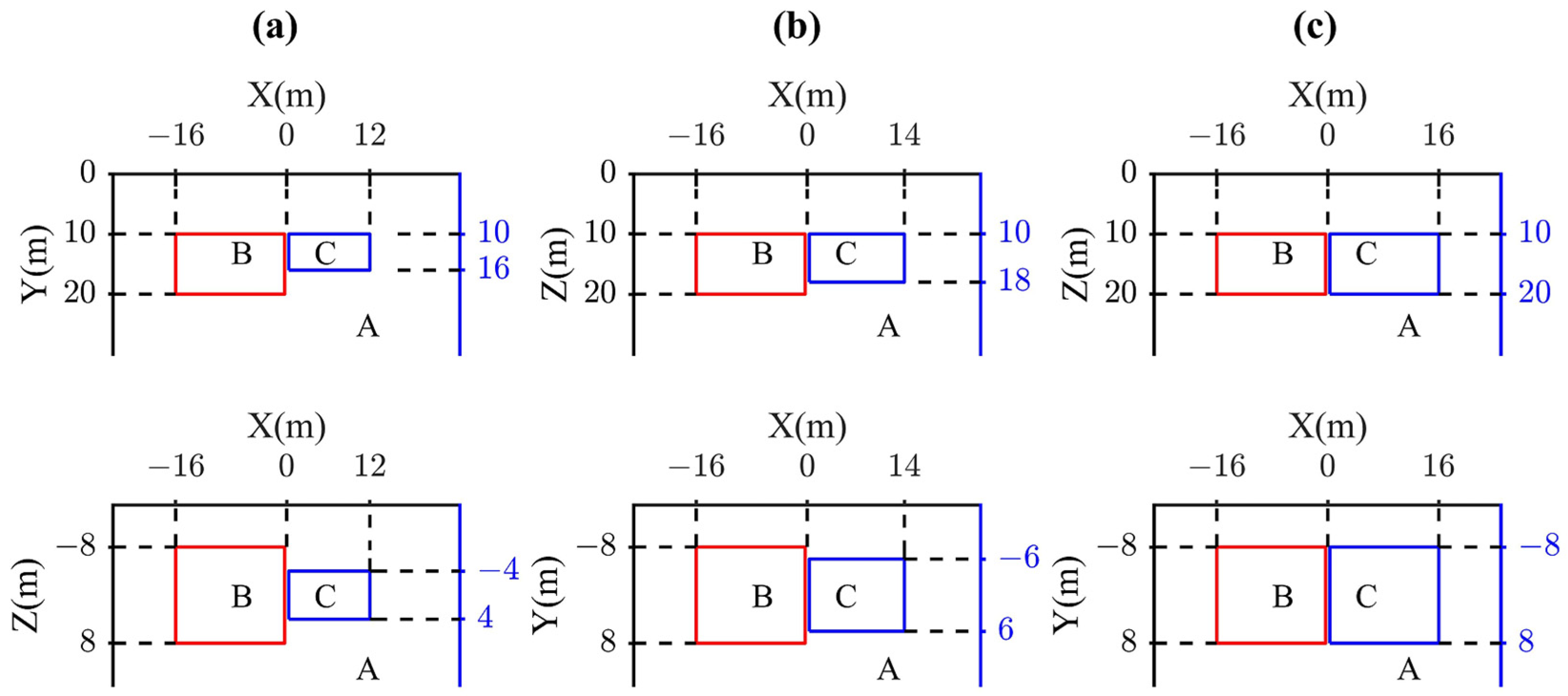
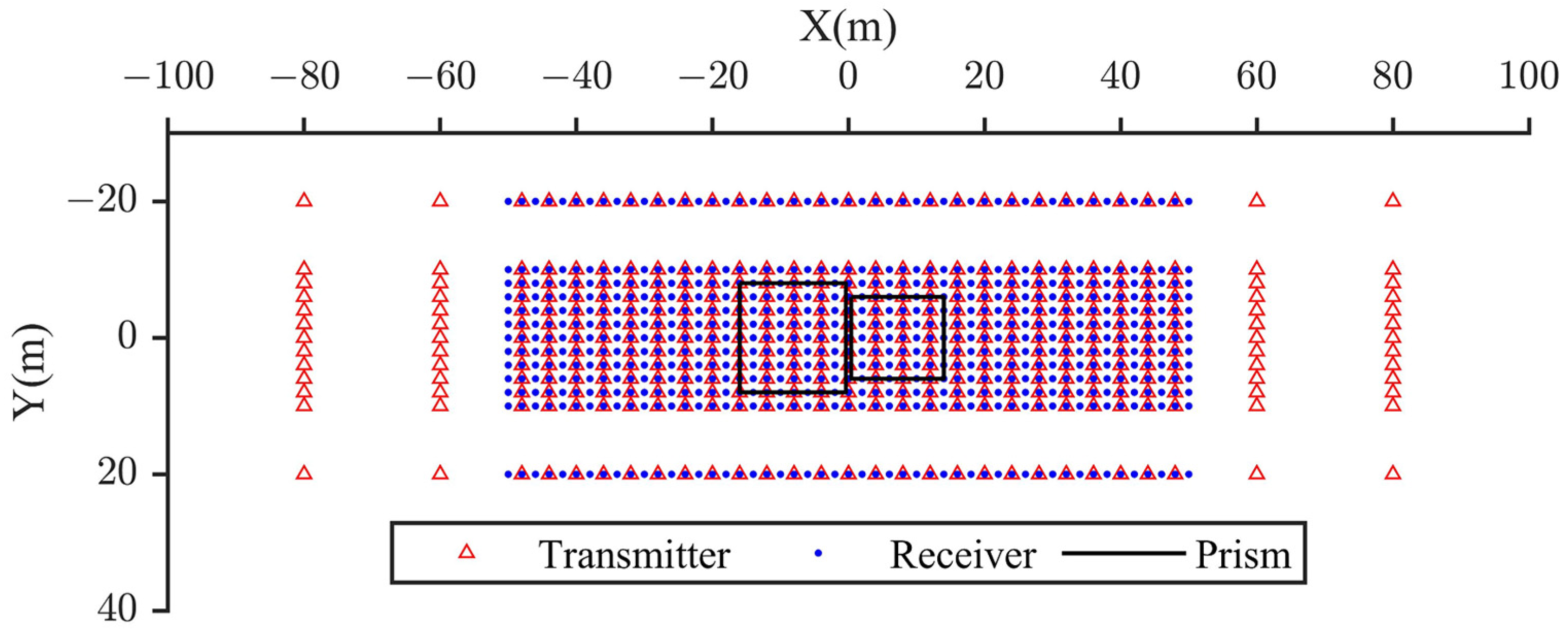
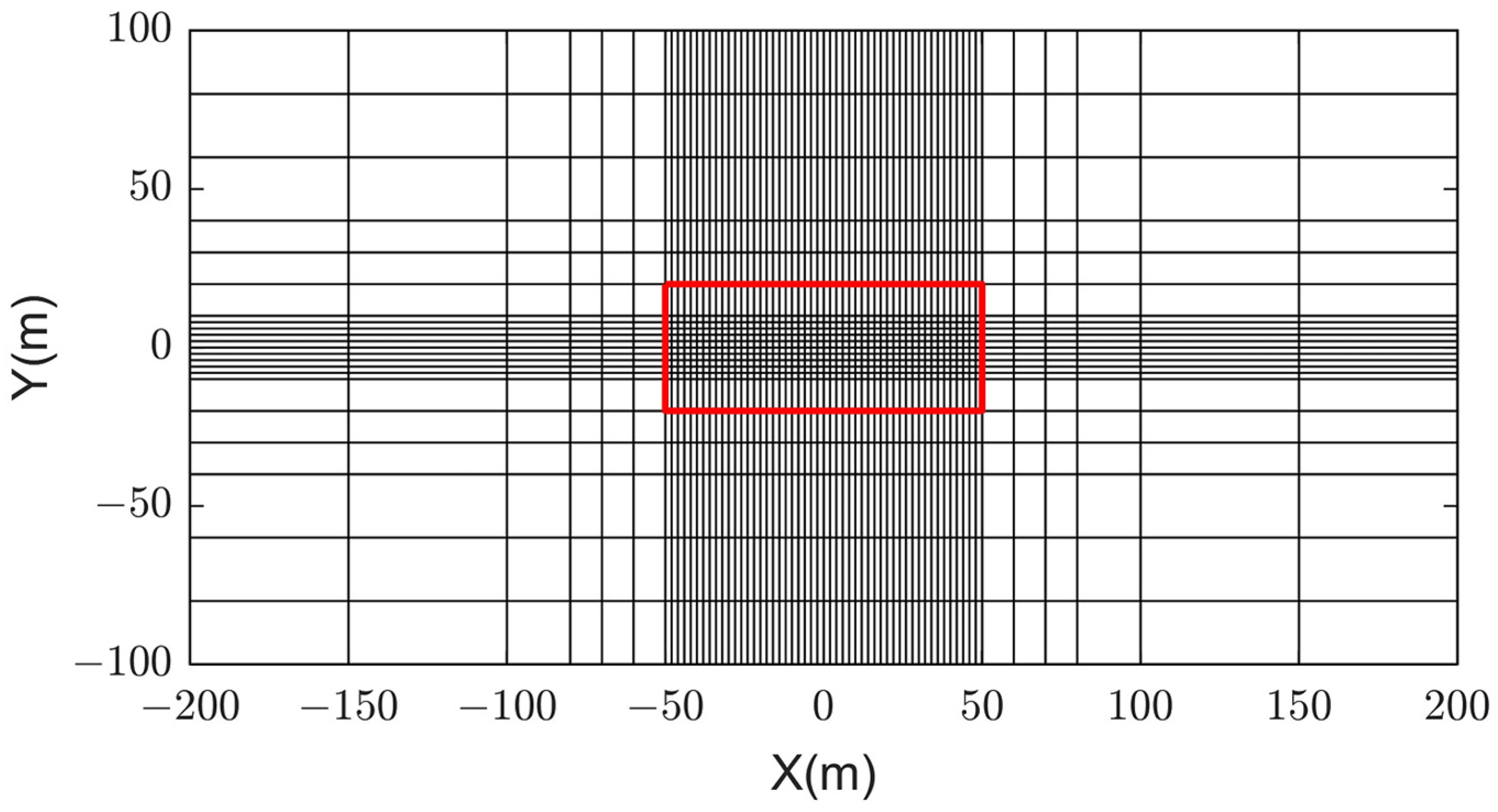
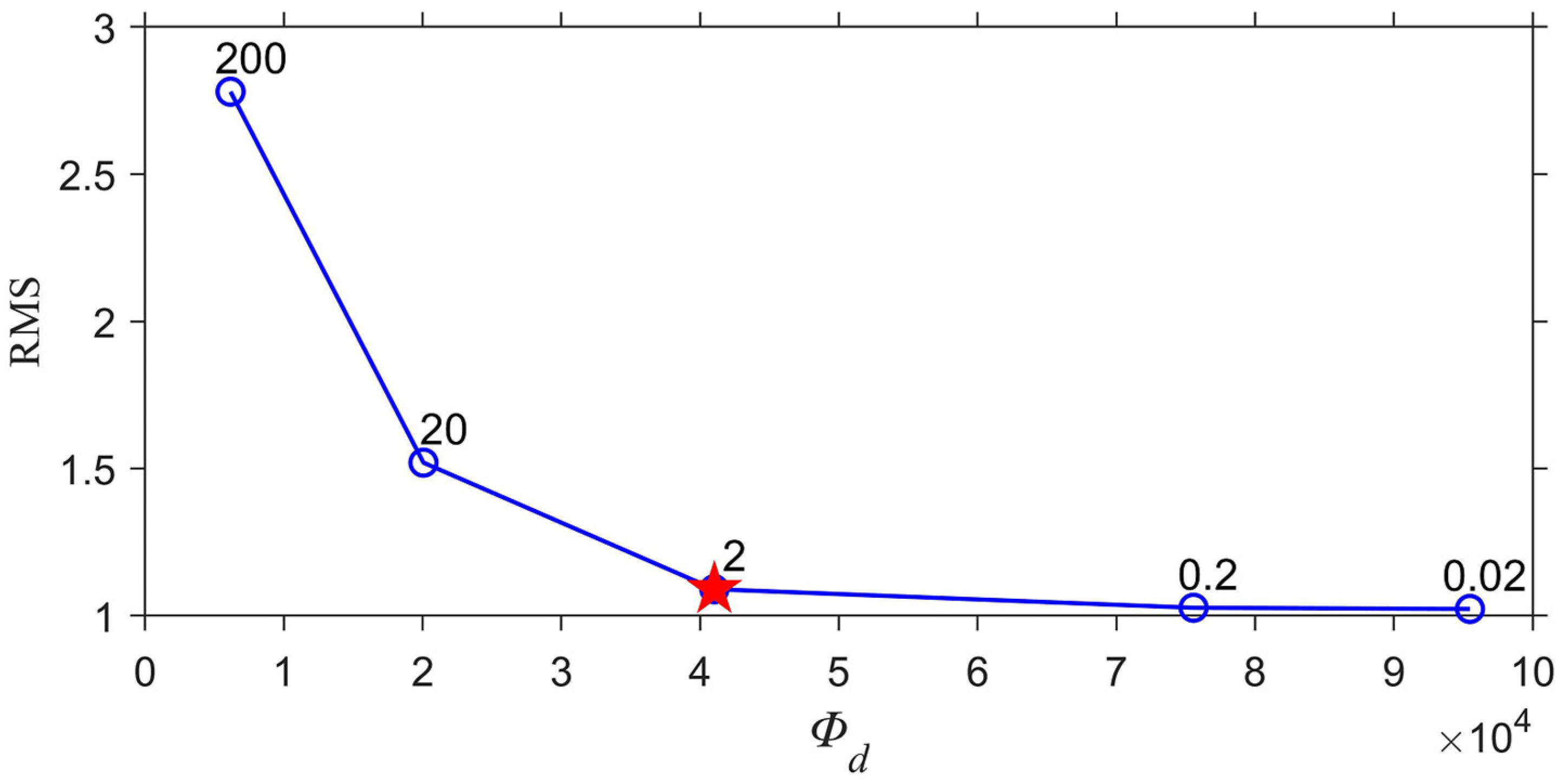
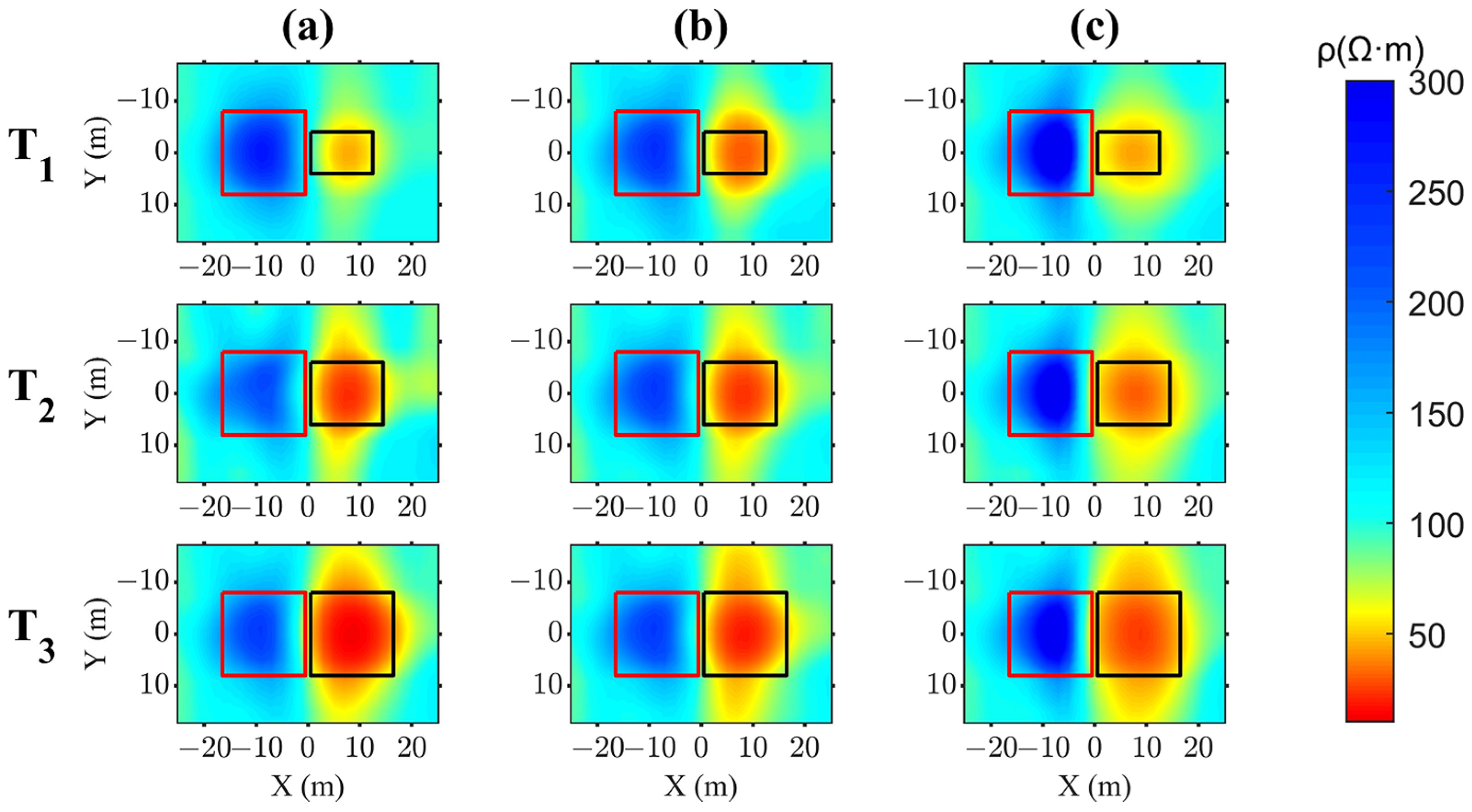
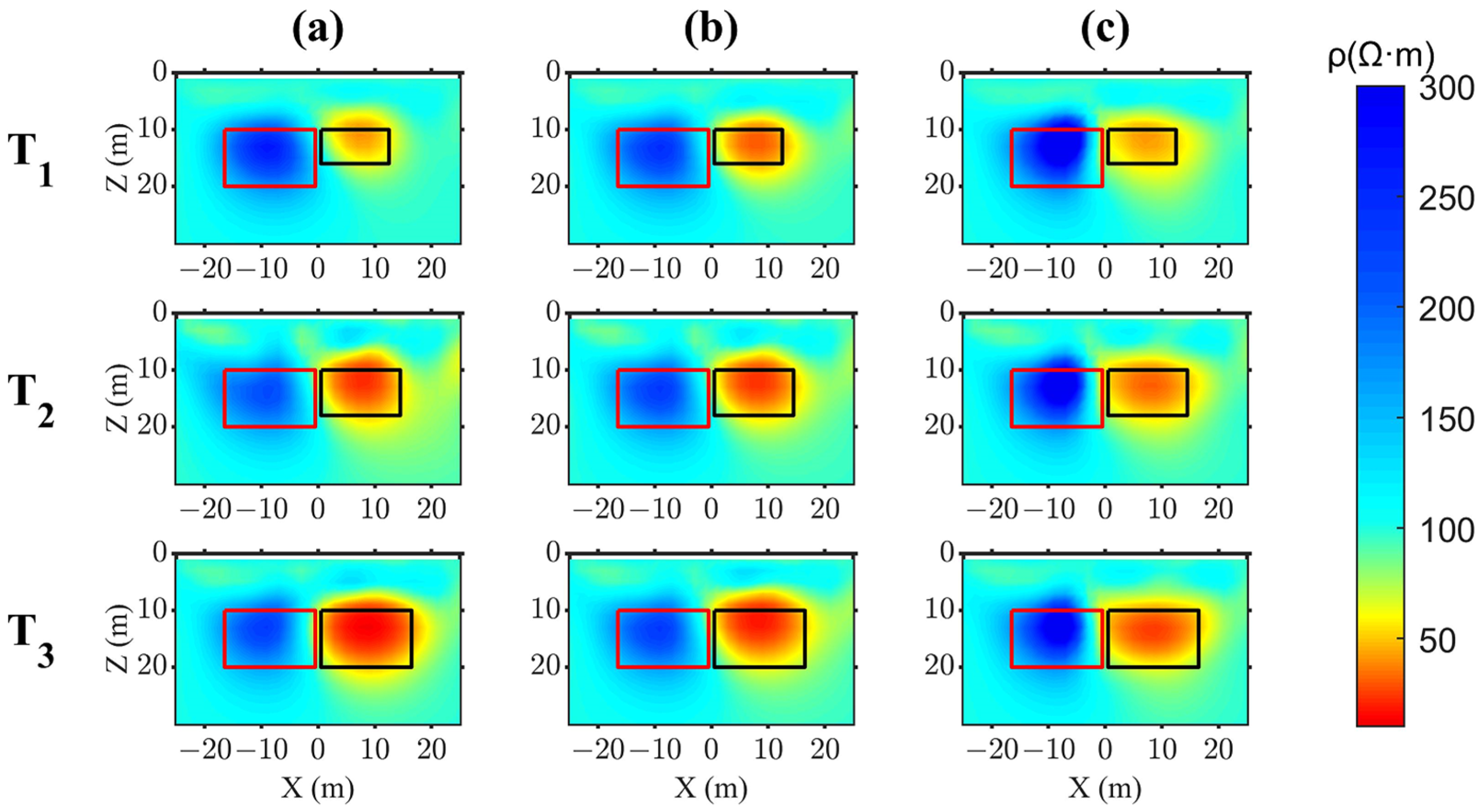


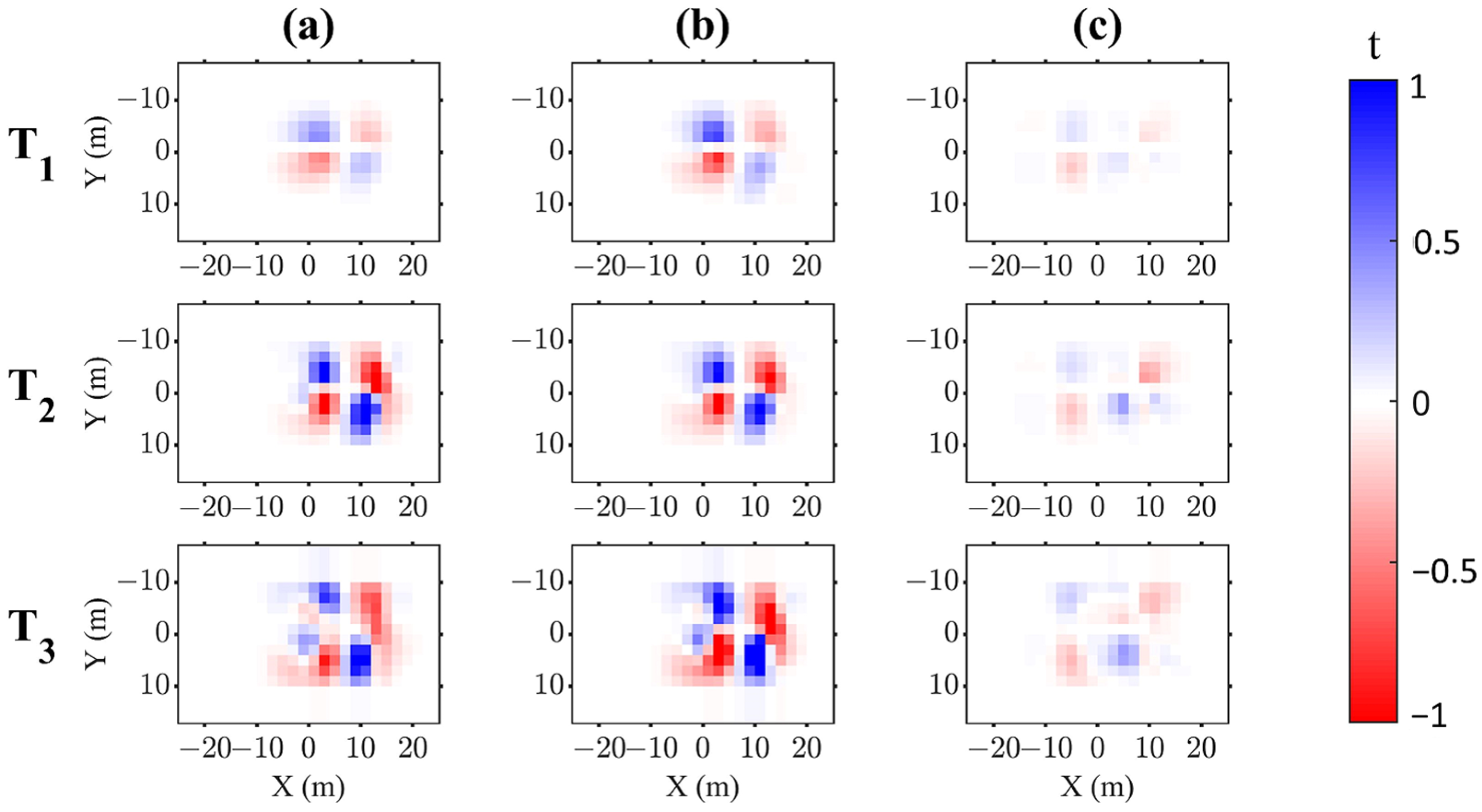
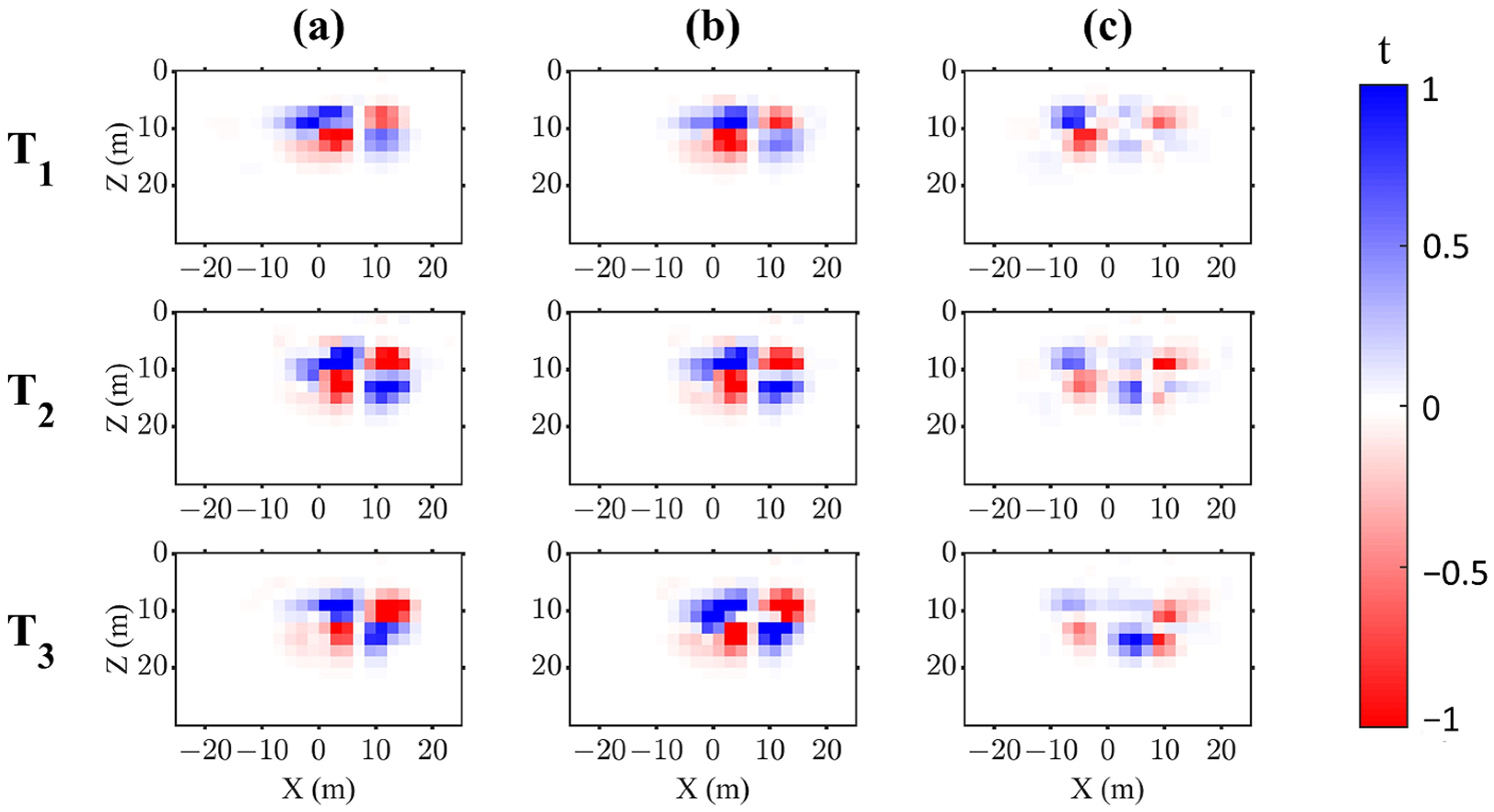
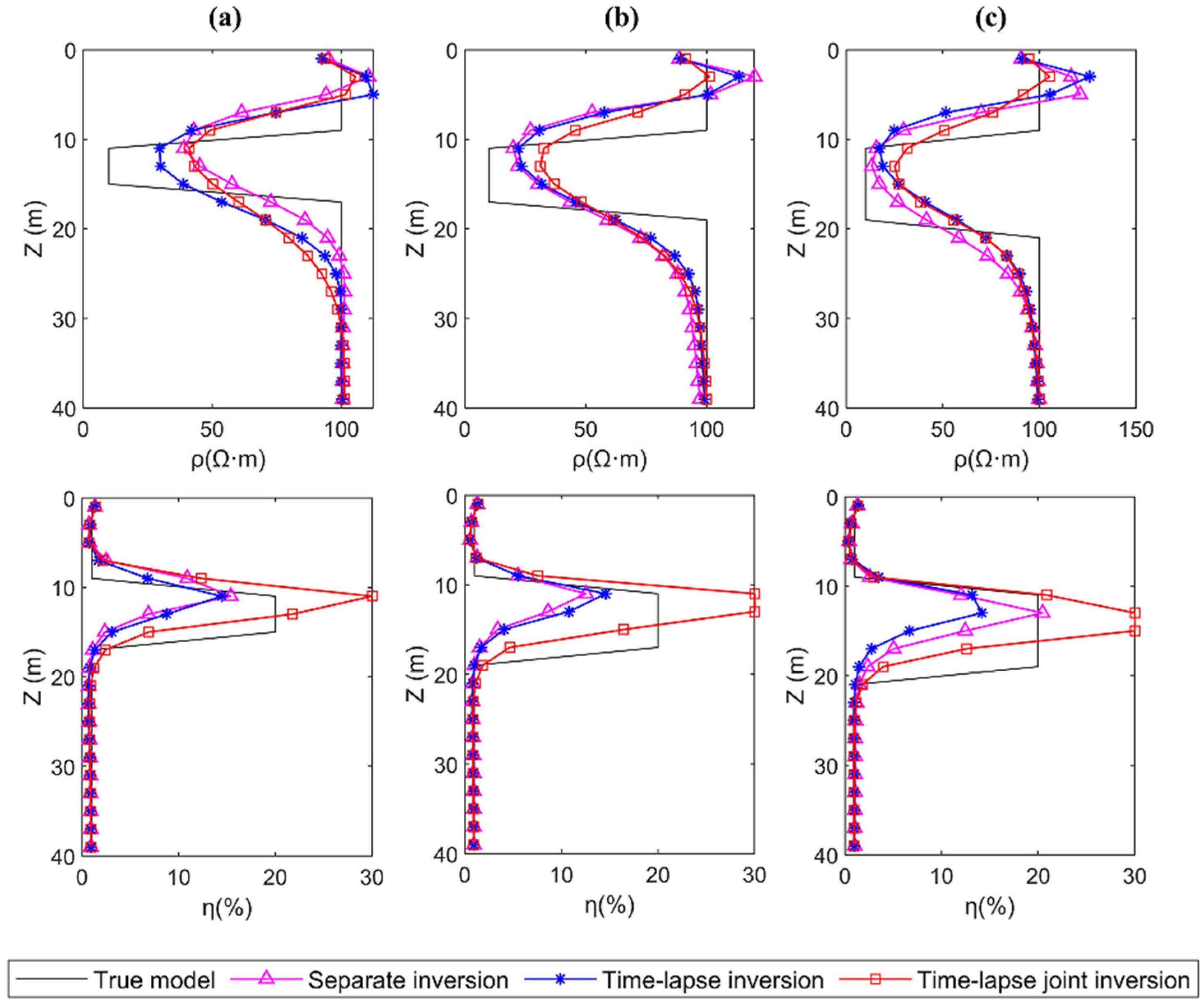
| Epoch | |||
|---|---|---|---|
| Separate Inversion | Time-Lapse Inversion | Time-Lapse Joint Inversion | |
| T1 | 6.45 × 10−6 | 1.10 × 10−5 | 3.53 × 10−6 |
| T2 | 2.93 × 10−5 | 2.01 × 10−5 | 3.17 × 10−6 |
| T3 | 1.95 × 10−5 | 3.15 × 10−5 | 3.01 × 10−6 |
| Parameter | Epoch | |||
|---|---|---|---|---|
| Separate Inversion | Time-Lapse Inversion | Time-Lapse Joint Inversion | ||
| T1 | 6.14 | 3.41 | 3.92 | |
| Resistivity | T2 | 5.65 | 5.87 | 5.47 |
| T3 | 5.71 | 10.22 | 7.92 | |
| T1 | 0.39 | 0.45 | 0.18 | |
| Polarizability | T2 | 0.44 | 0.48 | 0.33 |
| T3 | 0.81 | 0.89 | 0.56 | |
Disclaimer/Publisher’s Note: The statements, opinions and data contained in all publications are solely those of the individual author(s) and contributor(s) and not of MDPI and/or the editor(s). MDPI and/or the editor(s) disclaim responsibility for any injury to people or property resulting from any ideas, methods, instructions or products referred to in the content. |
© 2025 by the authors. Licensee MDPI, Basel, Switzerland. This article is an open access article distributed under the terms and conditions of the Creative Commons Attribution (CC BY) license (https://creativecommons.org/licenses/by/4.0/).
Share and Cite
Zhu, D.; Ma, H.; Yang, Y. Three-Dimensional Time-Lapse Joint Inversion of Resistivity and Time-Domain Induced Polarization Methods. Appl. Sci. 2025, 15, 10016. https://doi.org/10.3390/app151810016
Zhu D, Ma H, Yang Y. Three-Dimensional Time-Lapse Joint Inversion of Resistivity and Time-Domain Induced Polarization Methods. Applied Sciences. 2025; 15(18):10016. https://doi.org/10.3390/app151810016
Chicago/Turabian StyleZhu, Depeng, Huan Ma, and Youxing Yang. 2025. "Three-Dimensional Time-Lapse Joint Inversion of Resistivity and Time-Domain Induced Polarization Methods" Applied Sciences 15, no. 18: 10016. https://doi.org/10.3390/app151810016
APA StyleZhu, D., Ma, H., & Yang, Y. (2025). Three-Dimensional Time-Lapse Joint Inversion of Resistivity and Time-Domain Induced Polarization Methods. Applied Sciences, 15(18), 10016. https://doi.org/10.3390/app151810016






